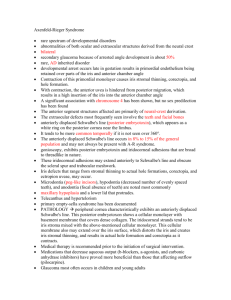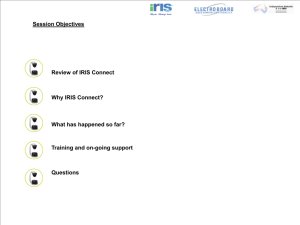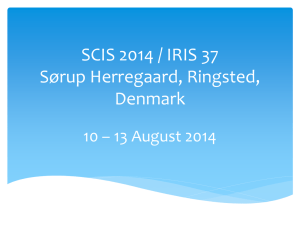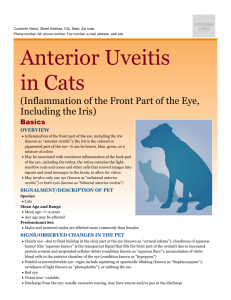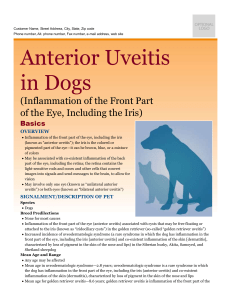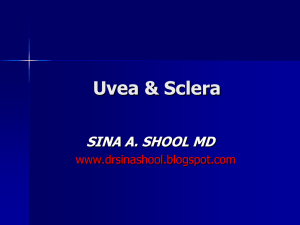iridocyclitis
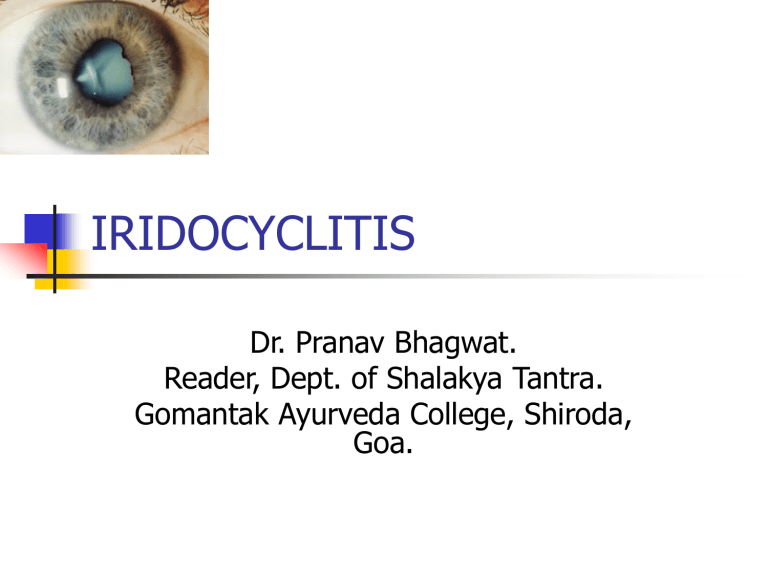
IRIDOCYCLITIS
Dr. Pranav Bhagwat.
Reader, Dept. of Shalakya Tantra.
Gomantak Ayurveda College, Shiroda,
Goa.
DEFINITION:-
The inflammation of uveal tract.
Classification-
A. Anatomical Classification –
(IUSG) International Uveitis Study
Group
1) Anterior Uveitis – Inflammation of iris and anterior part of ciliary body.
2) Intermediate Uveitis – Involvement of posterior part of ciliary body and extreme periphery of retina. (Pars planitis)
3) Posterior uveitis – Retinochoroiditis, choroiditis, retinitis, chorioretinitis
4) Diffuse or pan uveitis – Involvement of entire uveal tract
B. Clinical Classification -
1) Acute – sudden symptomatic onset.
Persists for 6 weeks or less.
2) Chronic – Frequently insidious and asymptomatic. Persists for months or years.
C. Etiological Classification
One of the most difficult problems in ophthalmology.
In most of the cases, probably, allergy is the cause.
1) Exogenous-
introduction of organism into the eye through a perforating wound or ulcer. acute iridocyclitis of suppurative type, pan-ophthalmitis.
2) Secondary infection-
Due to direct spread from adjoining structures-
Cornea
Sclera
Retina
3) Endogenous
Bacterial e.g. TB, Syphilis, gonorrhea
Viral e.g. Mumps, Small pox, influenza
Protozoal e.g. toxoplasmosis
4) Allergic inflammation
Result of an antigen-antibody reaction occurring in the eye due to previous sensitization of uveal tissue to some allergen. The allergen is a foreign protein.
Most of the cases of iridocyclitis do not have any specific cause and are probably allergic in nature.
5)Auto-immune/Constitutionala)Immune disorders affecting the body as a whole have ocular manifestations in the form of iridocyclitis.
e.g. rheumatoid arthritis, SLE, ankylosing spondylitis,
Reiter’s syndrome, Behcet’s Syndrome.
b) response to antigenic stimuli in other part of the eye.
Iridocyclitis is a common accompaniment of severe corneal infection and choroiditis of retinal inflammation.
HLA antigenic involvement
Disproportionately high percentage of patients of
B-27 antigenic group develop acute anterior uveitis.
D. Pathological Classification
Granulomatous Nongranulomatous
1. Aetiology Organismal invasion
Antigen-antibody reaction
2. Course a) Onset Insidious Acute b) Duration c) Inflammation
Chronic
Moderate
Short
Severe
Granulomatous Nongranulomatous
3. Pathology a) Lesion b) Iris
Circumscribed Diffuse
Focal reaction Diffuse reaction
Fine plenty c) Keratic precipitates
4.
Investigations
Mutton fat d) Iris adhesions Coarse, few, thick
May be positive
Fine, plenty, thin
Negative
PATHOLOGY AND
CLINICAL SIGNS-
Inflammation of iris and ciliary body
Dilatation of blood vessels
Iris stromal edema.
SIGNS - Iris pattern altered.Iris colour altered. Iris thickened.Also accompanied by, ciliary congestion, conjunctival hyperaemia and chemosis of conjunctiva.
Exudation of fibrin-rich fluid and inflammatory cells in the tissues
Exudates escape into anterior chamber
Plasmoid aqueous
SIGNS - Aqueous flare ( like the beam of projector in smokey theatre)
Nutrition of corneal endothelium is affected due to toxins
Corneal endothelium becomes sticky and edematous
Cells desquamated at places
Inflammatory cells stick to endothelial layer as cellular deposits .
SIGN – Keratic precipitates
In very intense cases, polymorphs pour out to sink to bottom of anterior chamber
SIGN – Hypopyon
Exudates cover the iris as a thin film and spread over pupillary area
SIGN – Irritation of iris musculature constrictor being more powerful than dilator, spasm results in miosis.
If exudate is profuse
SIGN – Plastic iritis
Blockage of pupil
SIGN – impairment of sight.
In early stages, there is adhesion of iris to lens capsule
(Atropine may free the iris)
SIGN – Spots of exudate or pigment derived from posterior layer of iris left permanently upon anterior capsule of lens (valuable evidence of previous iritis)
Later on, the organization of the adhesion leads to formation of fibrous bands between pupillary margin of iris and lens capsule
(atropine cannot rupture them)
SIGN – Posterior synechiae (more in lower part of pupil due to effect of gravity)
When adhesions are localized and a mydriatic is instilled, it causes intervening portions of circle of pupil to dilate.
SIGN – Festooned pupil
(due to irregular dilatation and is a sign of present or past iritis.)
Pigment epithelium on posterior surface is pulled around pupillary margin so that patches of pigment on anterior surface of iris are seen.
SIGN – Ectropion of uveal pigment
(due to contraction of organizing exudates upon iris)
With recurrent attacks or severe cases, the whole circle of pupillary margin gets tied to lens capsule.
SIGNS – Annular or ring synechiae or Seclusio pupillae
Collection of aqueous behind iris since aqueous drainage is hampered.
Iris is hence bowed forwards like sail.
SIGN – Iris Bombe (anterior chamber is funnel shaped i.e. deepest in centre, shallowest at periphery)
As iris bulges forward and comes into contact with cornea
Adhesions of iris to cornea at periphery develop
SIGNS – Peripheral anterior synechiae
Obliteration of filtration angle (Hypertensive iridocyclitis)
SIGNS – Rise in IOT (secondary glaucoma)
When exudate is more extensive
Organization of exudate across entire pupillary area
Film of opaque fibrous tissue in pupillary area
SIGNS – Occlusio pupillae or Blocked pupil
Exudates fill up posterior chamber if there is much of cyclitis
When these adhesions organize, the iris adheres to lens capsule.
SIGNS – Total posterior synechiae
When these adhesions organize, the iris adheres to lens capsule.
SIGNS – Total posterior synechiae
Retraction of peripheral part of iris
Anterior chamber is abnormally deep at periphery
In worst cases of plastic iridocyclitis
Cyclitic membrane formed behind lens
Finally, degenerative changes in ciliary body
Vitreous becomes fluid
Phthisis bulbi will be the eventuality.
Nutrition of lens impaired
SIGNS – Complicated cataract
In final stages, there is interference with secretion of aqueous
Fall in IOT
Eye shrinks (development of soft eye is an ominous sign)
SIGNS – Phthisis bulbi
Clinical Features
SYMPTOMS
Pain
Diminished vision
Redness of eye lacrimation photophobia haloes around light
SIGNS
Signs of vascular congestion
Signs of exudation
Signs of pupillary changes
Differential Diagnosis
Character Conjunctivitis Iridocyclitis Glaucoma
Infection Superficial Deep ----
Secretion Mucopurulent Watery
Pupil Normal Small, irregular
Watery
Large, Oval
Character Conjunctivitis Iridocyclitis Glaucoma
Media
Tension
Pain
Clear
Normal
Sometimes pupil opaque
Usually normal
Corneal oedema
High
Mild Moderate with first division of trigeminal
Severe and entire trigeminal
Character Conjunctivitis Iridocyclitis Glaucoma
Tenderness Absent Marked Marked
Vision
Onset
Good
Gradual
Systemic complications
Absent
Fair
Usually gradual
Poor
Sudden
Little Prostration and vomiting
Complications of Uveitis
Hypertensive uveitis – Secondary glaucoma
Endothelial opacities in cornea due to formation of keratic precipitates
Hypopyon and hyphaema suppurative uveitis may progress to end-ophthalmitis or pan-ophthalmitis toxic matter goes into lens – complicated cataract.
Post inflammatory atrophy of zonules – subluxation of lens vitreous – opacification of vitreous, liquification of gel, shrinkage of gel, retinal detachment
Contd..
…
macular edema optic neuritis – undergoes atrophy – optic nerve atrophy occlusive pupillae seclusion pupillae ectropion of uveal pigment hypotony – atrophic bulbi secondary squint iris atrophy
Investigations
Local vision, refraction, fundus examination
IOT by Schiotz Tonometer
Slit Lamp examination
Focal –
ENT, Dental, Genito-urinatory examination for septic focus.
For associated systemic disorders –
CBC, ESR, MT, X-ray chest – Tuberculosis
Urine, Blood examination-Diabetes
VDRL, Kahn Test – syphilis
Urethral smear – gonorrhoeae
Urine culture – for UTI
Blood culture – Septicemia
ASLO Titre, C-reactive protein – for rheumatic disorders
Screening test for auto immune disorders
Treatment
1.
2.
of iridocyclitis of complications and sequelae.
Treatment of Iridocyclitis
Drugs used –
Mydriatics
Steroids
Cytotoxic agents
Cyclosporin
Essentials of treatment of anterior uveitis
Dilatation of pupil with atropine
Hot application
Control of acute phase of inflammation with steroids
Atropine
Acts in 3 ways by keeping the iris and ciliary body at rest by diminishing hyperaemia by preventing formation of posterior synechiae and breaking down any already formed.
Method of administration and dose:
Atropine may be used in form of drops or ointment (1%) ,every four hours is usually sufficient.
When pupil is well dilated, twice a day suffices.
If atropine irritation ensues, one or the other substitutes for this drug may be used.
e.g. Homatropine, Cyclopentolate.
Mydriasis -the sub-conjunctival injection of 0.3 ml. of mydricaine, a mixture of atropine, procaine and adrenaline.
To avoid relapse-Atropine, or its equivalent -continued for at least 10 days to a fortnight after the eye appears to be quiet.
Hot application extremely soothing to patient by diminishing the pain.
of therapeutic service in increasing the circulation.
Corticosteroids
Administered as drops or ointment, or more effectively as subconjunctival injections are of great value in controlling the inflammation in the acute phase.
Occasionally, results are dramatic and eye becomes white with great rapidity.
Minimize damages of antigen antibody reaction.
Aspirin
Is very useful in relieving pain but if it is intense, stronger preparation are required.
Cytotoxic drugs in
Behcet’s disease
Sympathetic uvitis
Intermediate uveitis
Juvenile chronic arthritis
Cyclosporin
-T-cell immunosuppressive drug. Used in resistant cases.
Broad spectrum antibiotic
- In case of suppurative uveitis.
Specific Chemotherapy for Tuberculosis, syphilis, gonorrhoea.
Increasing body resistance by multivitamins.
Treatment of complications and sequelae-
Secondary glaucoma-
Before formation of posterior or peripheral synechiae,- intensify atropinisation in order to allay the inflammatory congestion.
Corticosteroids - topically and acetazolamide - systematically are very useful in such cases..
Annular synechiae-
Iridectomy ‘
( No operative procedure of this kind must be undertaken during an acute attack of iritis if it can be avoided. Reason – operation will set up a traumatic iritis which will result in the opening getting filled with exudates.) preventive iridectomy- Since ring synechiae is the result of recurrent attacks, iridectomy can be performed during quiescent interval.
Difficulty – iris is atrophied, friable. Haemorrhage is common. Synechiae can be broken with YAG Laser.
Hypopyon and Hyphaema may need evacuation and A.C. Wash.
End-ophthalmitis – intravitreal injection of
Decadron and Gentamicin
Pan ophthalmitis – Evisceration
Iris Bombe
Medical – 1. Atropine
Surgical – 1. 4-dot Iridotomy
2. Diamox using von Graefe’s knife
YAG Laser for breaking posterior synechiae
Ayurvedeeya approach
Iris -Seat of Vata dosha and Rakta and Mamsa dhatu.
In acute iridocyclitis the doshas - Vata-Pitta and dhatus - Rakta and Mamsa.
Chronic form doshas - Kapha and Pitta with the same dhatus..
There is a pathological process similar to
Abhishyanda and Adhimantha.
Hetu
Raktavaha srotodushti hetu:
Vidaahini annapaanaani snigdhoshnaani dravaani cha|
Raktavaahini dushyanti bhajataam chaatapaanalau||
[Cha. Vi. 5/14]
Mamsavaha srotodushti hetu:
Abhishyandaani bhojyaani sthulaani cha gurooni cha|
Mamsavaahini dushyanti bhuktvaa cha swapataam divaa||
[Cha. Vi. 5/15]
Pitta Pradhan Prakruti
Roopa
Raaga
Peedaa- shira-ardhashula. Worse @ nt.
Shirahpeedaa
Krushna-kalushatva
Krushna-stambha (drishti-sankoch)
Aakula-drishti
Sooryaprabhaam na veekshyate
Later on, drishti videerana
Samprapti
Hetusevan
Kapha-Pitta, Rakta-Mamsa dushti
Doshaanaam Urdhwagamanam
Netraanusaari Siraasu Praveshaah
Krishnabaage sthaan-sanshraya
Krishnabhaage abhishyanda
Doshaanaam vimaargagamanam
Sopadrava
Taramandal shotha.
Treatment
Agantuja / acute –
Vyadhena asanna krushnena raag: krushnam cha peedyate|
Tatraadh: shodhanam seka: sarpishhaa raktamokshanam||
[Su. Uttar. 17/74]
Virechana
Parisheka by sarpi
Raktamokshana
Nija / chronic-
1)
Raktavaha srotas chikitsakuryaat shonitarogeshu raktapittaharim kriyam/
Virekam upavaasam ca sravanam shonitasya ca//(ca. su. 24)
Mamsavaha srotas chikitsa- mamsajaanam tu samshuddhi: shastrakshaaragnikarma ca/(ca.su.28)
Aamapachana- langhana kaala tiktaka rasa pralepa – neelotpala, usheera, daarvi, yashtimadhu, mustaa, lodhra, shatadhauta ghrita
2) Shodhana
adhashodhana raktamokshana anjanam- raktabhishyanda (Patlyadi anjana) putapaka- same as above nasyam- shodhana followed by shamana.
3) rakta-mamsa bala vardhaka – sariva, loha, abhraka, ashwagandha.
Kapha-pittahara
Nasyam- to reduce abhisyandaa in shiras.
To reduce saamata in Rakta and Mamsa dhatu, required medications like
Manjishtha,darvi, musta, Patola should be used.
Treatment of aamavaata- Langhana, tiktaka rasa, deepana drugs, swedanam help to reduce abhishyanda and hence useful in this context.
This might be the appropriate treatment for Taramandal shotha.
THANK YOU!
-
